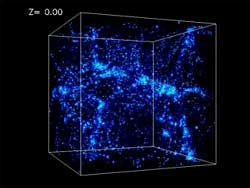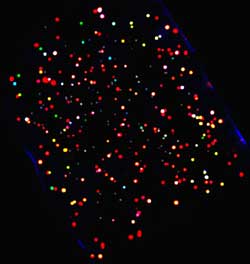Imagine the Universe News - 03 April 2003
Chandra Sees Shape Of Universe During Formative, Adolescent Years
| 03 April 2003 |
Scientists using NASA's Chandra X-ray Observatory have taken a snapshot of the adolescent universe from about five billion years ago when the familiar web-like structure of galaxy chains and voids first emerged.
The observation reveals distant and massive galaxies dotting the sky, clustered together under the gravitational attraction of deep, unseen pockets of dark matter. This provides important clues of how the universe matured from its chaotic beginnings to its elegant structure we see today.
|
These results were presented at the meeting of the High Energy Astrophysics Division of the American Astronomical Society at Mt. Tremblant, Quebec, March 23-26, 2003
"Piece by piece, we are assembling a photo album of the universe through the ages," said Yuxuan Yang, a doctorate candidate at the University of Maryland, College Park, who conducted the analysis. "Last month we saw a picture of the infant universe taken with the Wilkinson Microwave Anisotropy Probe. Now we can add a snapshot of its adolescence."
|
The Chandra observation traced a patch of sky known as the Lockman Hole in the constellation Ursa Major (containing the Big Dipper). Chandra saw a rich density of active galaxies, seven times denser than what has been detected in previous optical and radio surveys at similar distances. This provides the clearest picture yet at the large-scale structure of the universe at such distances (and age), according to Dr. Richard Mushotzky of NASA Goddard Space Flight Center in Greenbelt, Md., who led the observation.
If one could capture the universe in a box, scientists say that the large-scale structure -- that is, galaxies, galaxy clusters and voids of seemingly empty space -- takes the appearance of a web. Galaxies and intergalactic gas are strung like pearls on unseen filaments of dark matter, which comprises over 85 percent of all matter. Galaxies are attracted to dark matter's gravitational potential.
Dark matter does not shine, like ordinary matter made of atoms, and may very well be intrinsically different. Chandra's observation of distant galaxies in the Lockman Hole, spread out over several billion light years from Earth, essentially maps the distribution of dark matter. This provides clues to how the universe grew.
"We are seeing the universe during its formative years," said Mushotzky. "This is billions of years after galaxies were born, during a period when the universe began to take on the trappings of an adult."
The galaxies that the team saw with Chandra were either dim or altogether undetectable with optical and radio telescopes. This may be because they are enshrouded in dust and gas, which blocks radio waves and optical light. X-rays, a higher-energy form of light, can penetrate this shroud.
"Chandra is the only X-ray telescope with a spatial resolution comparable to the optical telescopes," according to Dr. Amy Barger of University of Wisconsin at Madison, who led the optical follow-up with the 10-meter Keck telescope on Mauna Kea, Hawaii. "This is critical to unambiguously identify the optical counterparts of the X-ray sources and measuring distances, or redshifts. This allows scientists to create a three-dimensional image of the large-scale structure."
The additive effect of future deep and long Chandra surveys over the next few years will provide an even sharper picture of the young universe. Other scientists who participated in this observation include Drs. Len Cowie and Dave Sanders of the University of Hawaii, and Ph.D. student Aaron Steffen of the University of Wisconsin at Madison.



